The Most Important Environmental Stories of 2022
The good, the bad, and the inspiring of the year that was
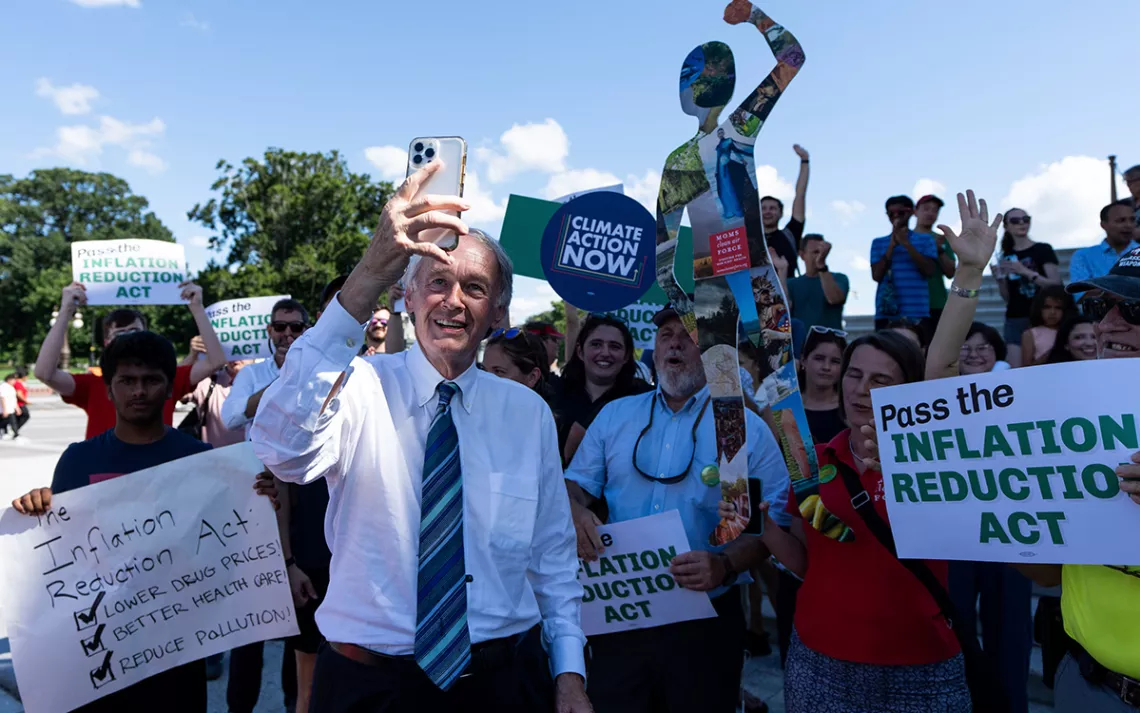
Senator Ed Markey shoots a selfie video with climate activists after the Senate passed the Inflation Reduction Act on August 7, 2022. | Photo by Bill Clark/CQ Roll Call via AP Images
The winter solstice has come and gone. Hanukkah is halfway over, and Christmas is right around the corner. The calendar will flip soon.
All of which means that it’s time for Sierra’s annual list of the most important environmental stories of the year—that is, the issues and topics that not only grabbed headlines this year but also will likely have a ripple effect for years to come.
Here’s the roundup of the good, the bad, and the inspiring from the year that was.
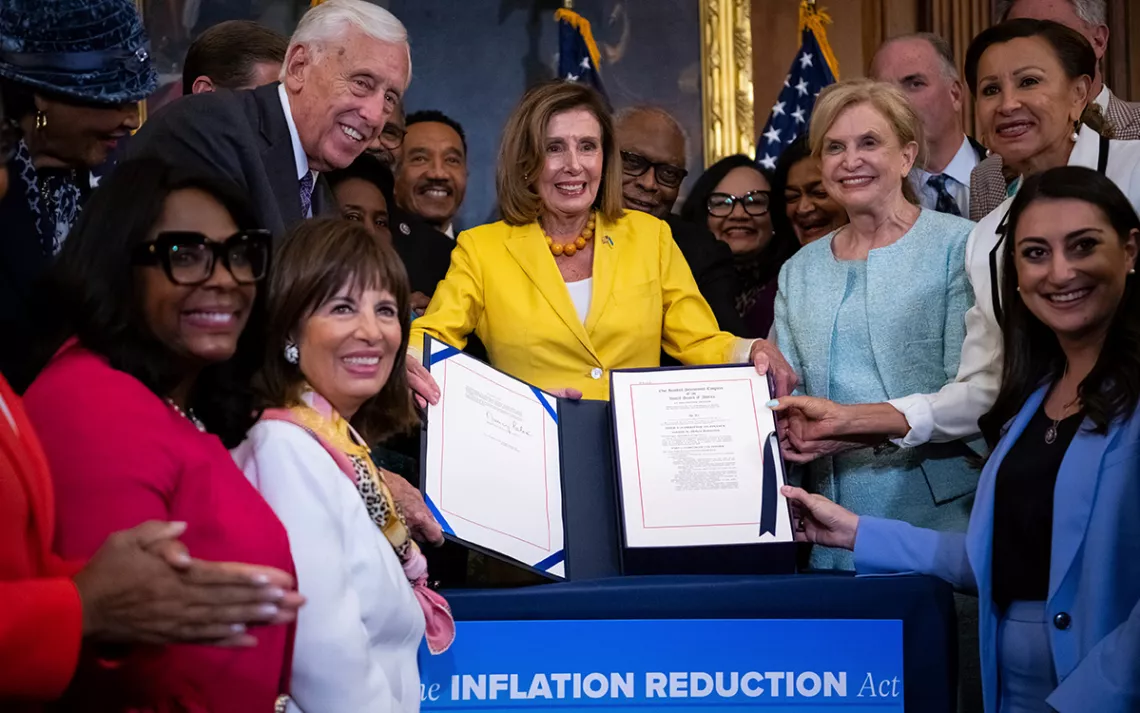
House Speaker Nancy Pelosi poses for a photo with members of the Democratic caucus after signing the Inflation Reduction Act. | Photo by Graeme Sloan/Sipa USA via AP Images
1. The Inflation Reduction Act
Finally.
In 2022, the US Congress finally, belatedly managed to do what should’ve been done years ago and passed sweeping legislation to address the climate crisis. The passage, in August, of the Inflation Reduction Act and its hundreds of billions of dollars worth of climate change provisions is by far the biggest environmental story of the year.
It was a heck of a political and emotional roller coaster to get there. Climate advocates spent the first part of the year agitating, organizing, and lobbying members of Congress to pass President Biden’s ambitious Build Back Better agenda, only to see West Virginia Senator (and coal magnate) Joe Manchin tank the whole deal in early July. But then ever-crafty Senate Majority Leader Chuck Schumer managed to snatch victory from the jaws of defeat, and by Labor Day the Inflation Reduction Act was the law of the land.
The final legislation is a slimmed-down version of Build Back Better. It’s a mere shadow of the original Green New Deal vision that animated environmentalists starting back in 2018, and it contains some awful giveaways to fossil fuel companies. And, at the same time, it’s a big frigging deal. The law contains roughly $370 billion in federal climate change investments that will speed the transition to wind and solar, accelerate the electric vehicle industry, help pioneer new clean energy technologies, address environmental injustices, and help protect carbon-capturing forests. If all goes according to plan, the law will slash US greenhouse gas pollution by 40 percent between now and 2030.
The accomplishment wouldn’t have been possible without the focus and determination of Schumer, House Speaker Nancy Pelosi, President Biden, and scores of congressional staffers—some of whom even engaged in an unprecedented sit-in on Capitol Hill in support of the legislation. Above all, this victory never would’ve happened had it not been for the years-long efforts of citizens around the country who marched, protested, and tirelessly lobbied their elected officials for climate action. It was the grassroots energy of the climate movement that made the IRA possible—and that’s worth raising a toast of good cheer.

Democratic Senator Raphael Warnock speaks during an election night watch party on December 6 in Atlanta. | Photo by John Bazemore/AP
2. Midterm Elections: Green Wave Helps Blunt Red Tsunami
Climate activists were so determined to pass climate legislation this year because they expected that environmental champions would lose control of at least one chamber of Congress. And, sure enough, Republicans—many of whom remain in the grip of climate science denial—took over the House of Representatives in the fall elections.
As you’ve no doubt heard, Republicans vastly underperformed historical trends for a midterm election; the “red tsunami” they promised was little more than a splash. What you may not have heard about is how climate-focused voters played a key role in some races—especially in crucial Senate races in Pennsylvania, Arizona, and Georgia. Younger voters overwhelmingly cast their ballots for Democrats. And survey after survey after survey has shown that, among such younger voters, climate change is a top concern. In tight races, climate voters can tip the scales.
Another green lining from the midterm elections: The passage of the IRA was a nonissue, and that’s a good thing. The fact that Republicans made no effort to weaponize the bill—as they did with earlier Democratic environmental initiatives in the 1994 and 2010 elections—shows that smart GOP operatives know that bashing clean energy is a political loser. “We passed major climate legislation, and you didn’t see anything as far as attack ads,” Jamal Raad, the cofounder and executive director of Evergreen Action, told Sierra the morning after the election.
The election victories of environmental champions at the state level were also clutch for future action on climate. Democrats racked up governing majorities in four new states—Minnesota, Michigan, Maryland, and Massachusetts—and held onto the governors' seats in Pennsylvania and Wisconsin. This is so important because successful implementation of the Inflation Reduction Act will rely on state and local governments tapping into the federal grants and loans created by the new law. With smart, progressive leadership now in place, the industrialized Great Lakes region has the potential to become a vast laboratory and workshop for the retooled clean energy economy.

Villagers walk in search of drinking water near Hyderabad, Pakistan. | Photo by Pervez Masih/AP
3. Summer Scorcher
This year may not go down as the hottest ever recorded, but it’ll be close. And, in any case, there’s no question that the summer of 2022 was a scorcher.
The initial furnace blast hit India and Pakistan in March and then extended well into April as high-temperature records going back to 1901 collapsed across the continent. To put the extreme weather in perspective: In 2021, India had 36 heat wave days; in 2022, it had more than 200.
As spring turned to summer, a heat wave gripped most of Europe. For the first time ever, large parts of the United Kingdom recorded temperatures over 40°C—or 100°F. Major European rivers like the Loire, the Po, and the Rhine diminished to record low levels. At one spot on the Elbe River, the water levels dropped low enough to reveal “hunger stones” once used to forecast famines. One stone, carved in 1616, read “If you see me, cry.”
There was no escaping the heat. A long-lasting heat dome settled over much of the American West in September. China experienced its highest temperatures ever recorded and its third-worst heat wave.
Such extreme heat can be deadly. Europe’s hottest summer on record may have resulted in some 20,000 excess deaths. And even when heat isn’t lethal, it can crush people’s ability to work, to think, and to be nice. According to a recent report from the International Red Cross and Red Crescent, global economic losses related to heat stress could jump from $280 billion in 1995 to $2.4 trillion in 2030. And these stresses will be distributed unequally: Low-income countries will experience the biggest losses, and by mid-century most of the urban poor suffering from extreme heat will be in West Africa and Southeast Asia. But even wealthy countries like the US will feel impacts. Hotter weather makes people more irritable, and according to one new study, between 2015 and 2020 some 8,000 shootings in the United States can be attributed to unseasonably warm temperatures.
Unfortunately, this year’s heat waves are just a taste of what’s to come. With global greenhouse gas pollution continuing to rise, the 2022 heat waves could go from feeling “extreme” to feeling “normal.”
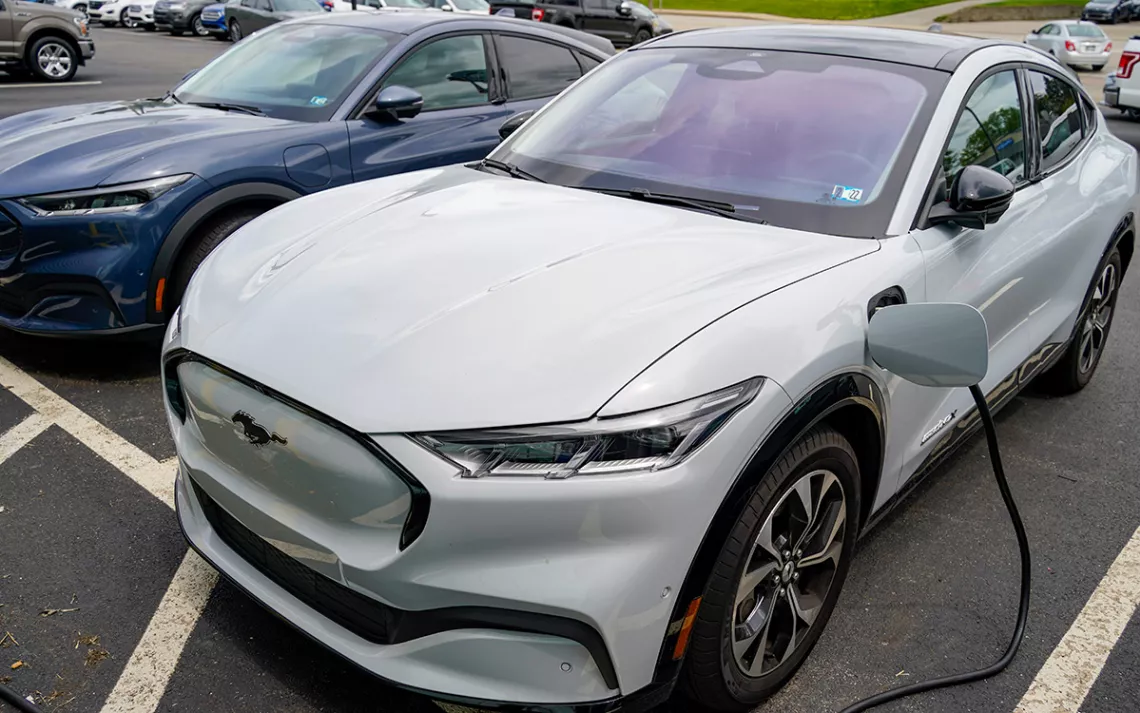
A pair of 2021 Ford Mustang Mach-E's at a dealership in Wexford, Pennsylvania. | Photo byKeith Srakocic/AP
4. Peak ICE Is Likely Here
You know what else was hot in 2022? Sales of electric vehicles. For years, transportation experts and climate-action advocates have been saying that electric vehicle dominance is right around the corner. It now appears we’ve reached the hoped-for destination.
This year will very likely go down in history as the moment when we reached “Peak ICE”—that is, the summit of global sales of internal combustion engines (ICE). From this point forward, annual sales of electric vehicles will likely eclipse sales of internal combustion engines, according to a report from Bloomberg NEF.
The evidence is all around. In 2022, an estimated 13 percent of light-duty vehicles sold globally will be EVs. That includes more than a quarter of all vehicles sold in China. Here in the United States, more than 6 percent of all vehicles sold this year will be electric—which may not sound like a lot until you consider that the figure is three times what it was just two years ago. In August, California announced that the state will prohibit the sale of new gas-powered cars by 2035. At least five states are considering following that move.
The acceleration of the EV market is so crucial because transportation makes up such a big slice of total carbon pollution. In the United States, transportation is the number one source of carbon pollution; globally it’s the second biggest source. There’s simply no way to address the climate crisis without ensuring that every car and truck has a plug, and that all the energy from that plug comes via carbon-free sources.
Fortunately, the road ahead for EVs now looks wide open.
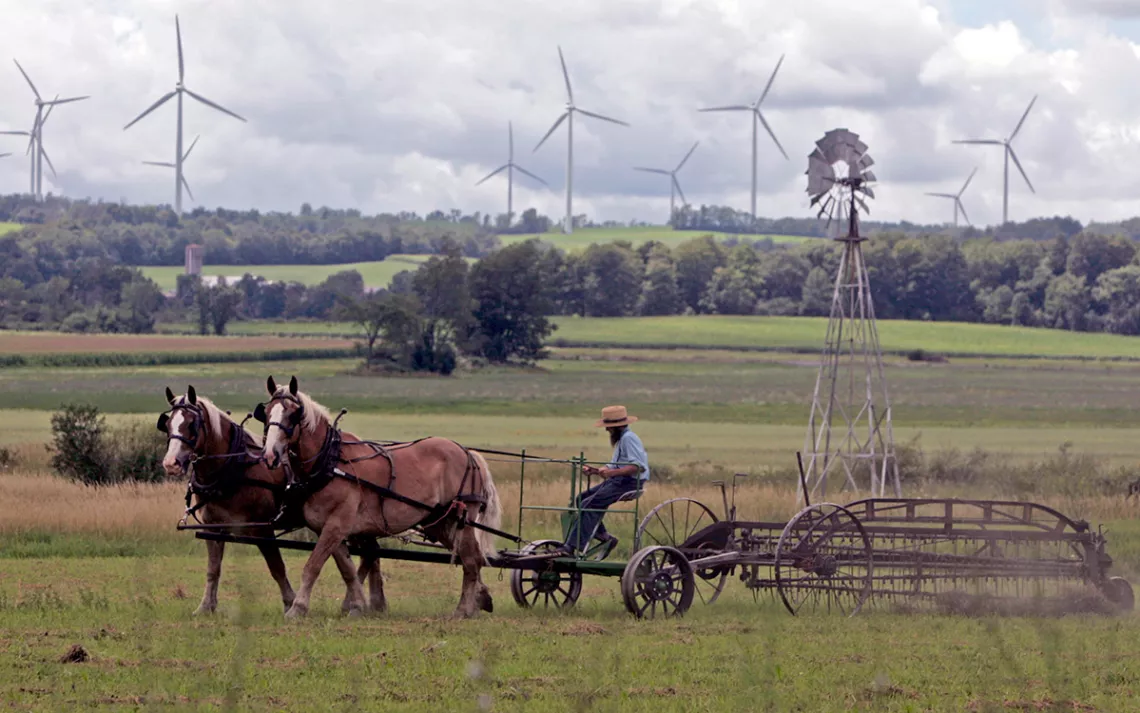
An Amish farmer in Lowville, New York. | Photo by Mike Groll/AP
5. Markets and Investors Opt for Clean Energy
This one is something of a sleeper story—a wonky, insider topic that didn’t get a ton of public attention but which will likely have seismic consequences.
In 2022, for the first time ever, global investments in renewable energies topped investments in oil and gas extraction. According to independent firm Rystad Energy, investments in renewables will be $494 billion while investments in oil and gas will be $446 billion. It’s one important sign of how banks and other investment firms are increasingly placing their bets on the clean energy future.
Now, it’s not all roses. Some 80 percent of major banks’ total energy portfolios are still centered on coal, oil, and gas. And US banks like JPMorgan Chase, Citibank, Wells Fargo, and Bank of America remain some of the biggest backers of dirty fuels. But a growing number of public and university pension funds are pulling out of fossil fuels altogether. That has the fossil fuel financiers spooked, as you can tell by listening to their overheated reaction to what they call “woke capitalism.” You know you’re winning the public debate when the other side is acting defensively.
Fossil fuel financiers and their political allies are no doubt anxious because they can see the long-term trends. In October, the International Energy Agency released a forecast showing that total global demand for fossil fuel energy could peak within a decade. A dollar invested in fossil fuels today runs a real risk of being a stranded asset 15 years from now. And that’s why the savviest investors are putting their money elsewhere—a story that you’ll likely be reading much more about in the year to come.
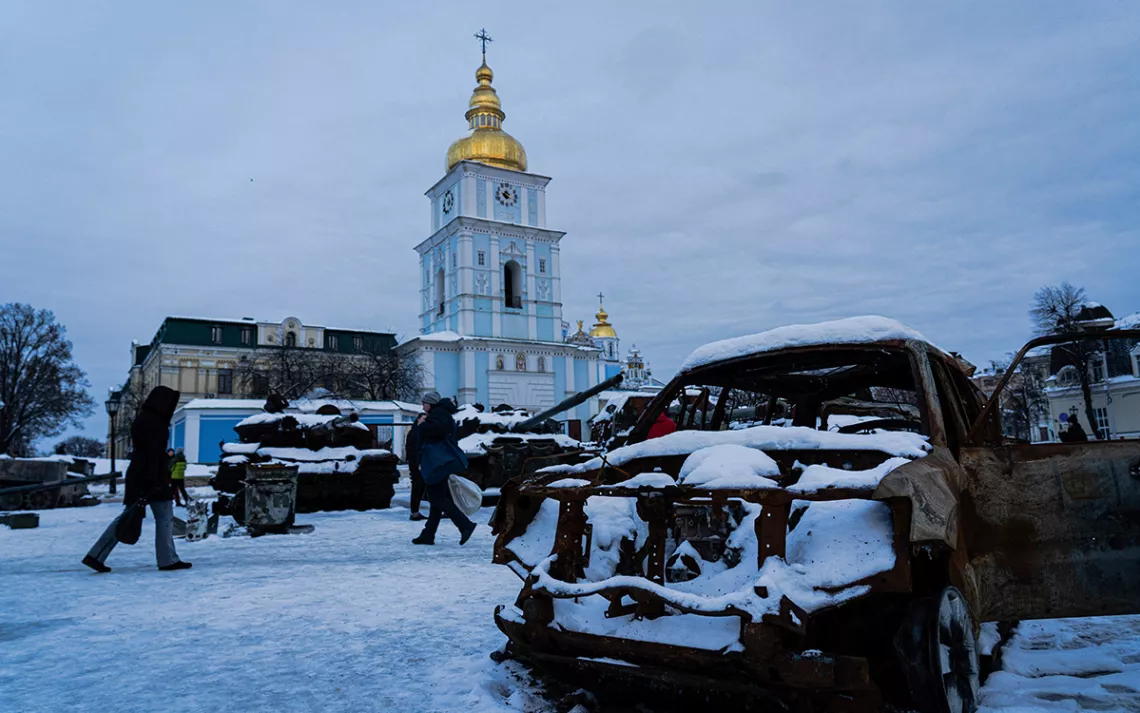
Wreckages of Russian military vehicles in front of the St. Michael's Golden-Domed Monastery. Ukrainians experienced winter under war this year. | Photo by Ashley Chan/SOPA Images/Sipa USA via AP Images
6. Russian Invasion of Ukraine Accelerates Move to Clean Energy
The forecast plateau of fossil fuel use has one perhaps surprising driver: the war in Ukraine.
When Russia illegally invaded its neighbor last February, many energy analysts expected that the conflict would spike greenhouse gas emissions. Russia is an oil and gas powerhouse, and the European Union relies heavily on Russian gas for heating and electricity. The EU’s decision to slash Russian gas imports as a way of supporting the beleaguered Ukrainians has, in fact, led to an increase in coal burning on the continent.
But that’s a story about the short term. In the long run, the IEA predicts, skyrocketing oil and gas prices sparked by the war will likely speed up the transition to renewable energies. In part, this is just a function of economics. Europe’s wholesale energy market for gas hit a record high this summer, and the high cost of gas combined with the relatively low cost of renewables will help move energy markets toward wind, solar, and other noncarbon sources.
Mostly, Europe’s redoubled interest in renewables is a matter of geopolitics. Leaders there know that their long-standing reliance on Russian fossil fuels makes them, at best, vulnerable to price shocks created by Russian aggression and, at worst, funders of Vladimir Putin’s war. “If we were to stop the purchase of Russian energy, that would stop the funding of the Russian military machine,” Latvian prime minister Krisjanis Karins said in spring. In July, EU leaders voted to more than double the amount of energy they get from renewables by 2030—a move that explicitly was a reaction to Russian aggression.
Putin evidently thought he could use his nation’s vast oil and gas reserves as a geopolitical weapon to prevent other nations from coming to Ukraine’s aid. In response, the European democracies are racing to use renewables as a kind of geopolitical shield. The war in Ukraine has made clearer than ever that one of the surest routes to improving global peace and security is to break the power of petro-dictators like Putin.
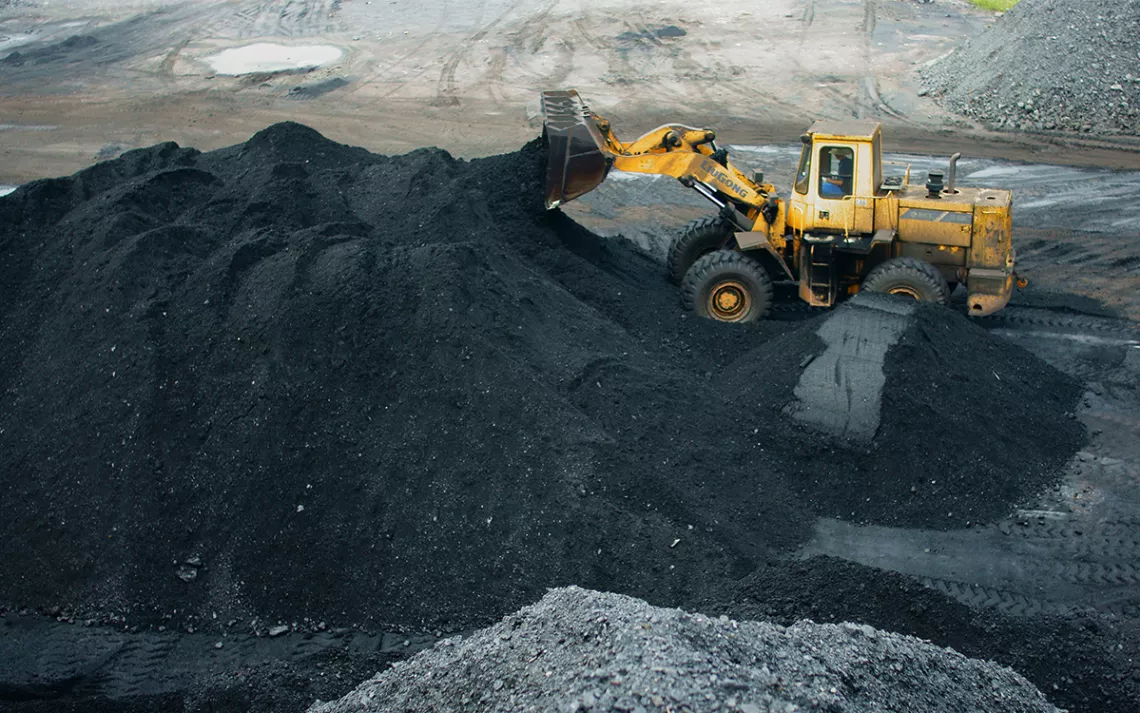
A worker drives a wheel loader at a coal yard in Yichang, China. | Imaginechina via AP Images
7. Global Coal Use Increases
The eventual peak, plateau, and decline of global fossil fuel use may be on the horizon—but it’s not here yet. The world’s economies remain shackled to dirty energy sources, and perhaps nothing makes that clearer than the fact that global coal use increased in 2022.
This is real bummer news—especially since it’s a reversal from nearly a decade of progress. Global coal use has been mostly on a downward trajectory since 2013, driven in large part by the steady closing of US coal plants (thanks to the Sierra Club’s Beyond Coal campaign). This year, in contrast, global coal use ticked up 1.2 percent. As explained earlier, the war in Ukraine was part of the problem. Much of this year’s coal surge, however, came from China, India, and Indonesia. All three of those countries will hit record coal-production numbers this year.
This is such an important story because it reveals how much work we still have to do in order to decarbonize. Yes, it’s great that the US Congress passed the IRA; it’s hugely encouraging that investors are turning toward renewables. And it’s also true that the required scale and scope and speed of the clean energy transition is unlike anything civilization has ever attempted before.
In the clinical language of the analysts at the IEA, “coal demand is stubborn.” In order to turn away from this dirtiest of dirty fuels, government leaders, corporate executives, and climate activists will have to be even more stubborn.
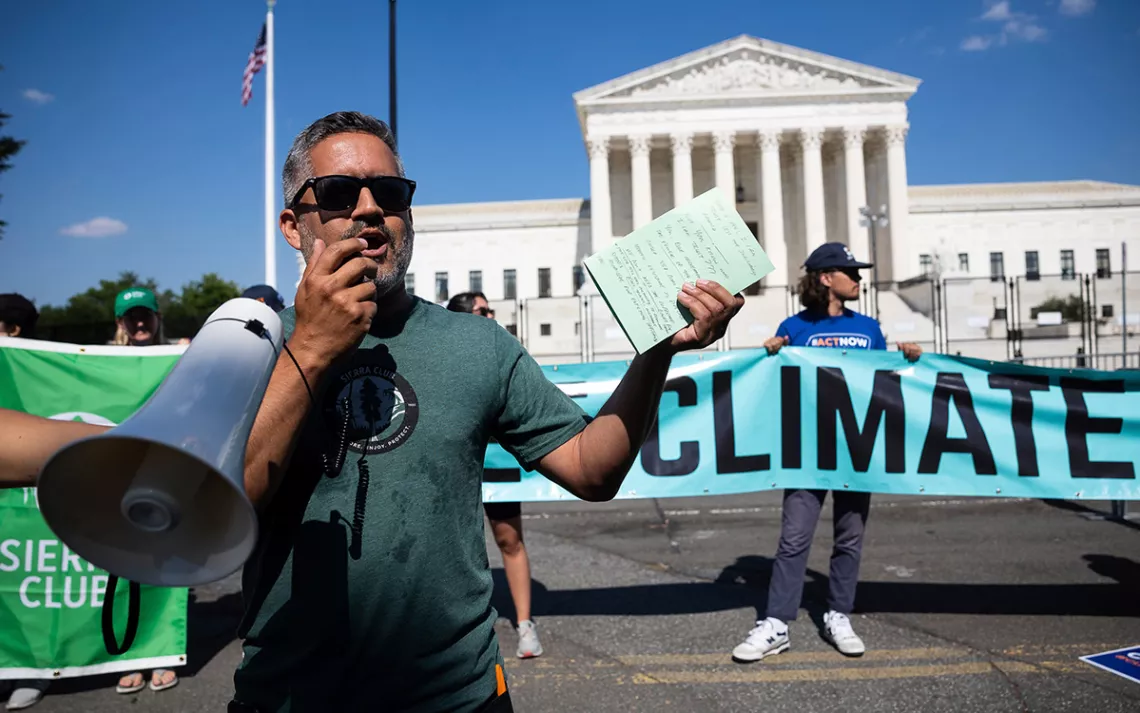
Sierra Club president Ramón Cruz during a rally outside the Supreme Court after its decision on West Virginia v. EPA on June 30. | Photo by Francis Chung/E&E News/POLITICO via AP Images
8. US Supreme Court Goes Gunning for the “Administrative State”
In its rush to remake American society, the US Supreme Court tackled so many big issues this year—gun control, immigration, the separation of church and state, and women’s reproductive freedom—that you may not have noticed the case of West Virginia v. EPA. But it’s one you should know about since it’s a case in which the conservative super-majority signaled, once again, its hostility to the federal government’s ability to safeguard the environment and public health.
On its face, West Virginia v. EPA was about the technicalities of the Clean Air Act and whether the Obama-era Clean Power Plan was constitutional. At its heart, the case was the culmination of a decades-long effort to hamstring what’s known as “the administrative state”—that is, modern, effective government.
Even before the oral arguments took place, veteran environmental attorneys were nervous as the justices had gone out of their way to take a case that was obviously moot, since the Clean Power Plan never went into effect. And while the final ruling was bad (it struck down the EPA’s working plan for slashing carbon pollution from power plants), the decision wasn’t as awful as some feared (the court kept intact the EPA’s ability to regulate greenhouse gas emissions).
But environmental lawyers were still left spooked. The most worrisome aspect of the ruling was the conservative justices’ promulgation of a whole new legal theory called the “major questions doctrine” that seeks to limit the power of the executive branch to manage issues that may have a significant impact on US society or economy. Writing on Twitter, Harvard Law School professor Jody Freeman said the court’s “embrace of the Major Questions Doctrine [is] ominous.”
Why ominous? Because the court’s conservative justices appear intent on establishing a new standard for the constitutionality of federal rule-making—a standard that could threaten not just environmental protections but also a range of other public health and safety regulations. After the ruling was released, Sierra Club attorney Andres Restrepo warned that the decision “will embolden opponents of agency regulations to challenge any agency action they don’t like and claim it’s a major question. Badly needed safeguards protecting public health and welfare will be held hostage to whether it’s a ‘major question.’”
In her dissent, Justice Elena Kagan wrote: “The Court today prevents congressionally authorized agency action to curb power plants’ carbon dioxide emissions. The Court appoints itself—instead of Congress or the expert agency—the decision-maker on climate policy. I cannot think of many things more frightening.”
Kagan’s fear is spot on—and reason enough to keep an eye on the Supreme Court’s environmental docket in the year to come.
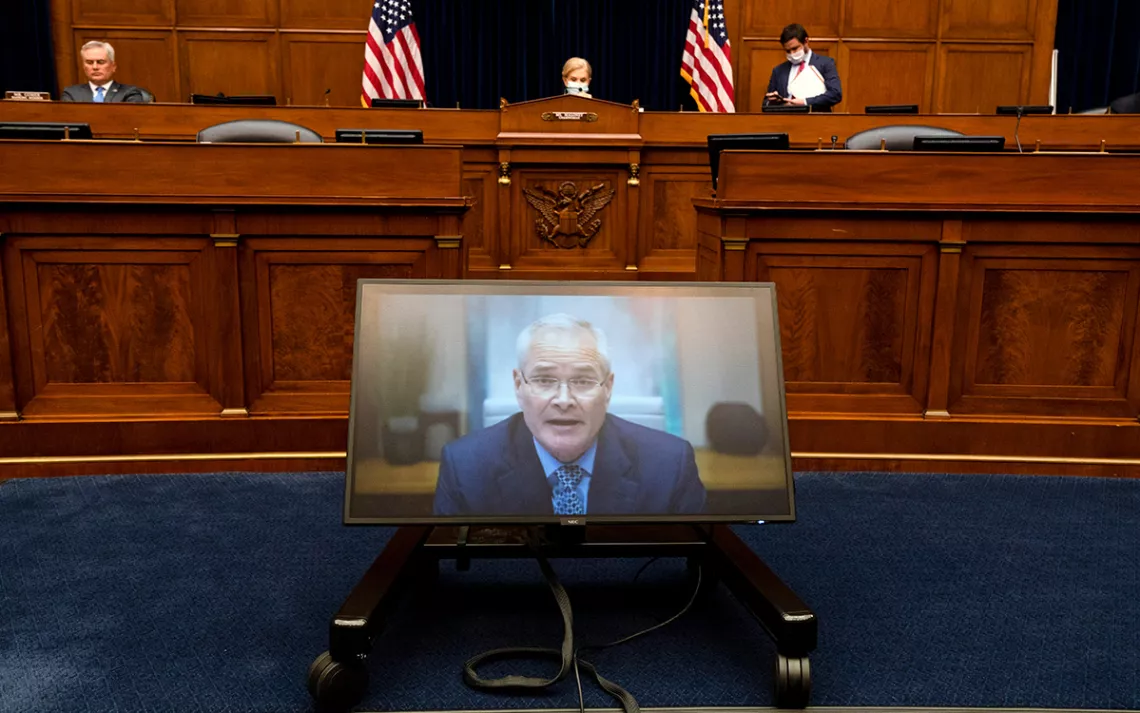
Darren Woods, CEO of ExxonMobil, testifies during a House Committee on Oversight and Reform hearing on the role of fossil fuel companies in climate change. | Photo by Jacquelyn Martin/AP
9. Big Oil in the Hot Seat
The conservative majority on the Supreme Court may not be interested in addressing the climate crisis, but in 2022 one of the other co-equal branches of government did use its authority to try to hold powerful actors accountable for the crisis.
This year, the House Oversight Committee continued a series of hearings, started in 2021, to investigate the major oil companies’ role in fueling global warming. Above all, the House investigation sought to uncover whether and how the oil corporations and their trade associations spread disinformation about climate science—disinformation that likely derailed and delayed US political action on climate.
In December, the committee made public the conclusions from all of its research, subpoenas, and testimonies. “Despite knowing the truth about climate change, fossil fuel companies continued to contradict prevailing scientific knowledge and inject confusion into the public debate over climate change,” chair Carolyn Maloney of New York wrote in a memo outlining the investigation’s findings. “Rather than outright deny global warming, the fossil fuel industry has ‘greenwashed’ its record through deceptive advertising and climate pledges—without meaningfully reducing emissions.”
Or, shorter: For years, Big Oil lied about the severity of the climate crisis; Big Oil continues to mislead the public about its supposed commitment to address the crisis; and members of Congress have the evidence to prove it all.
Many climate activists have hoped that the congressional investigation would be a repeat of the late-'90s probing of Big Tobacco—a chance to finally hold a powerful industry accountable for deadly deception. It may not go down that way. The oil companies are especially skilled and slippery at avoiding public scrutiny, as Representative Ro Khanna has observed. And with the climate-change enablers in the GOP about to take over the House, the investigations will come to a halt.
Here’s a hopeful takeaway: All the material gathered by the House Oversight Committee will prove useful to the growing number of state, county, and city lawsuits targeting Big Oil. New Jersey in October filed a suit against the oil companies for misleading the public about climate change. And in November, 16 municipalities in Puerto Rico filed a lawsuit under racketeering statutes, alleging that the oil companies colluded to spread climate disinformation.
You can bet that in 2023 the drumbeat of climate accountability will grow louder.

Protesters interrupt a speech by Canada prime minister Justin Trudeau during the opening ceremony of COP15, the UN biodiversity conference in Montreal, on December 6. | Photo by Paul Chiasson/The Canadian Press via AP
10. A Global Agreement to Preserve Biodiversity
All of the important stories listed above have one thing in common: They are each, in some way, centered on climate and energy. It’s essential to remember, though, that the climate crisis isn’t the only globe-spanning environmental threat. While it gets far less media attention, less activist energy, and fewer philanthropic resources than the climate crisis, there’s another huge danger to life on Earth: the extinction emergency.
According to the World Wildlife Fund’s Living Planet Report, wildlife species populations have declined by an average of 69 percent since 1970. The climate crisis and the extinction emergency may be intersecting and overlapping, but it’s important to remember that they are distinct phenomena. For now, at least, rising temperatures aren’t the main driver of wildlife losses. The main cause of wildlife diminishment is old-fashioned habitat loss, mostly in the form of agriculture, as humans continue to convert forests and grasslands into crop fields and grazing lands. Or, as journalist Michael Grunwald recently put it, “When we eat cows, chickens, and other livestock, we might as well be eating macaws, jaguars, and other endangered species.”
This year, the world’s governments finally came up with a plan for addressing the die-offs. Meeting in Montreal under the auspices of the UN’s Convention on Biological Diversity, 190 nations agreed to protect 30 percent of the planet’s lands and waters by 2030. (The United States, maddeningly, is not a party to the convention.) The agreement also has explicit language guaranteeing Indigenous peoples’ land rights and acknowledging Native communities’ unique contribution to protecting flora and fauna.
Some people have described the new deal sealed in Montreal as “a Paris Agreement for biodiversity.” That could be either praise or critique. Like the Paris Agreement, the new biodiversity is inspiring in its ambition. It’s also nonbinding and unfunded, and it remains unclear where all the money will come from to meet the big goals.
But the Kunming-Montreal Global Biodiversity Framework (yeah, it’s a mouthful) is at least an important first step. “We are finally starting to forge a peace pact with nature," UN Secretary-General António Guterres said, celebrating the accord.
Let’s hope so—it’s reason enough for some holiday good cheer.
 The Magazine of The Sierra Club
The Magazine of The Sierra Club



